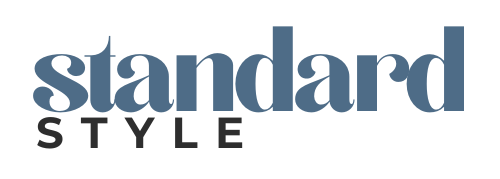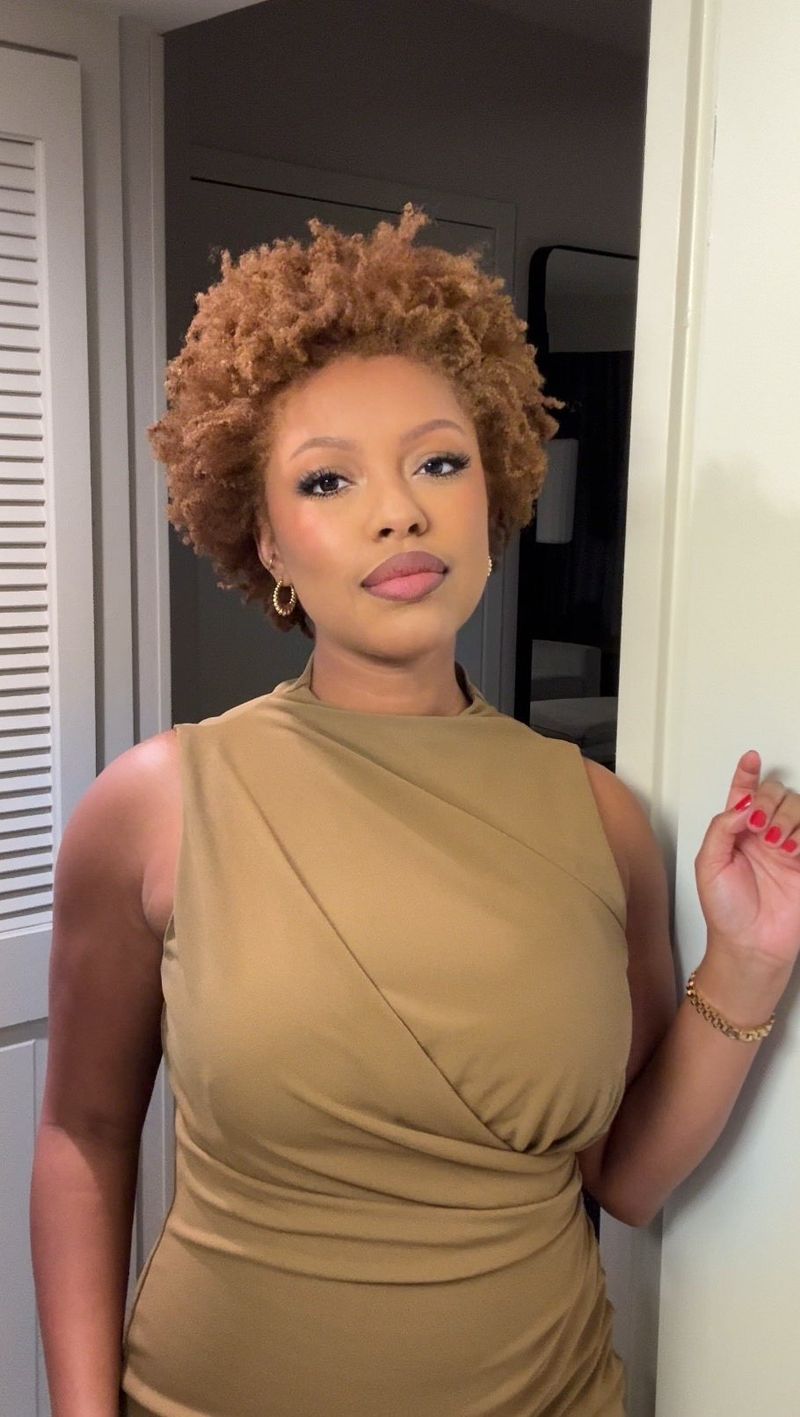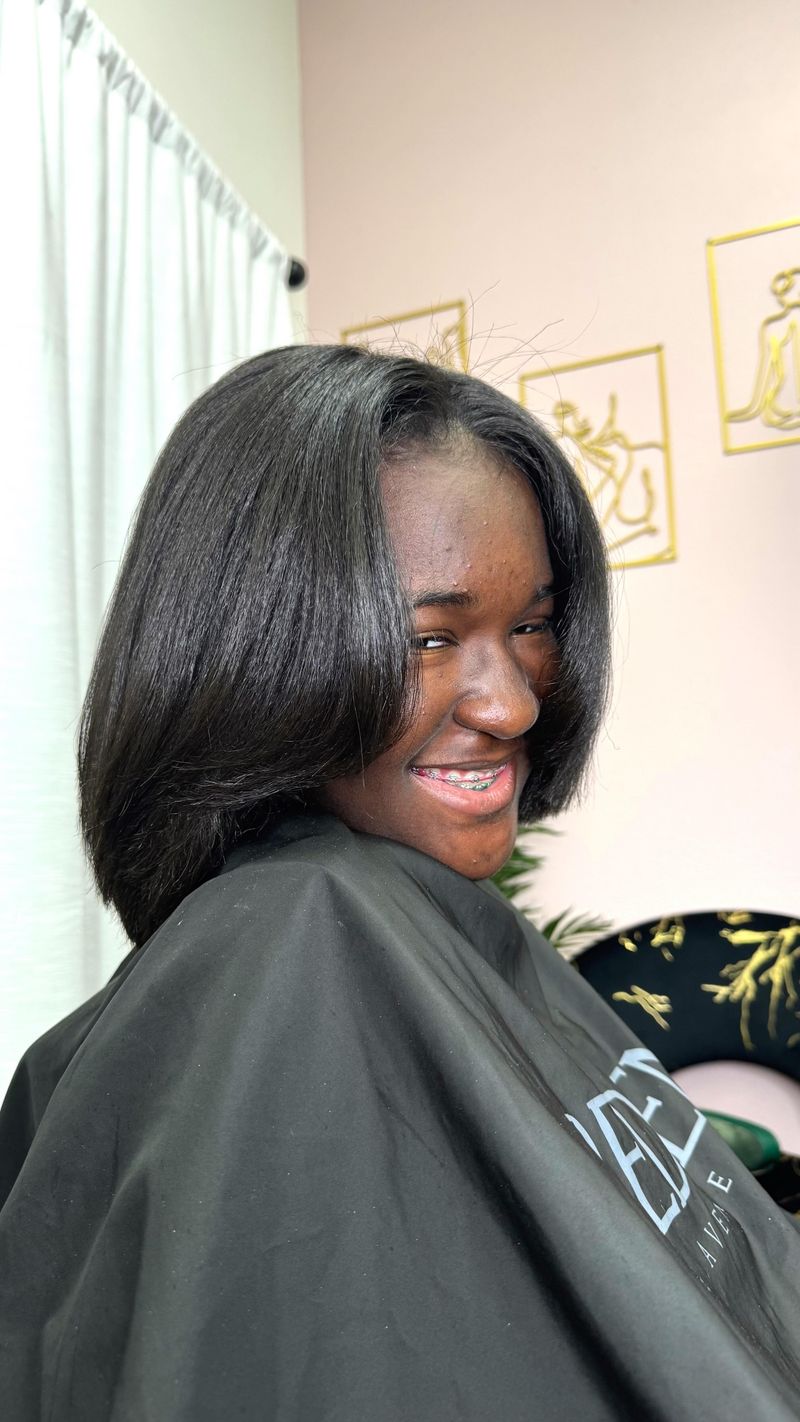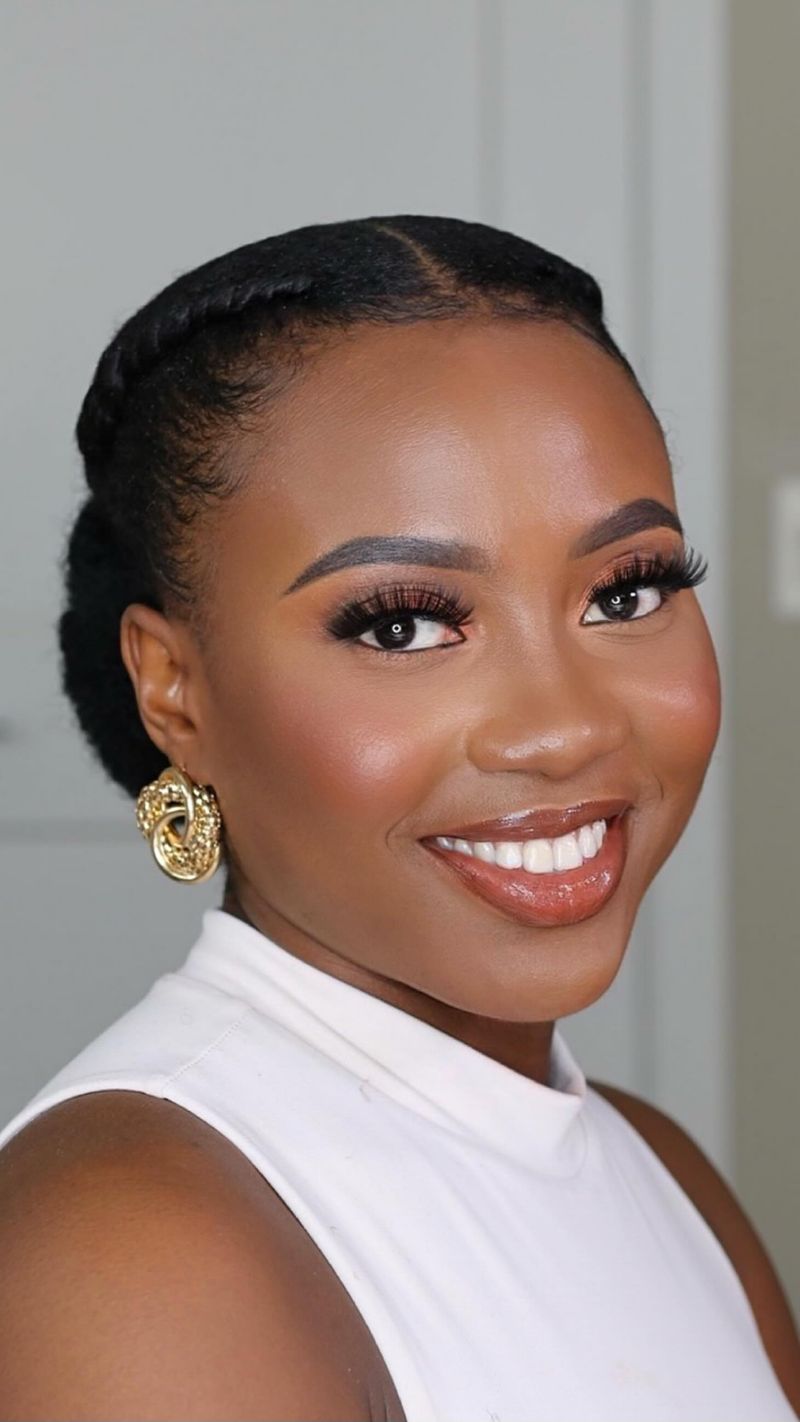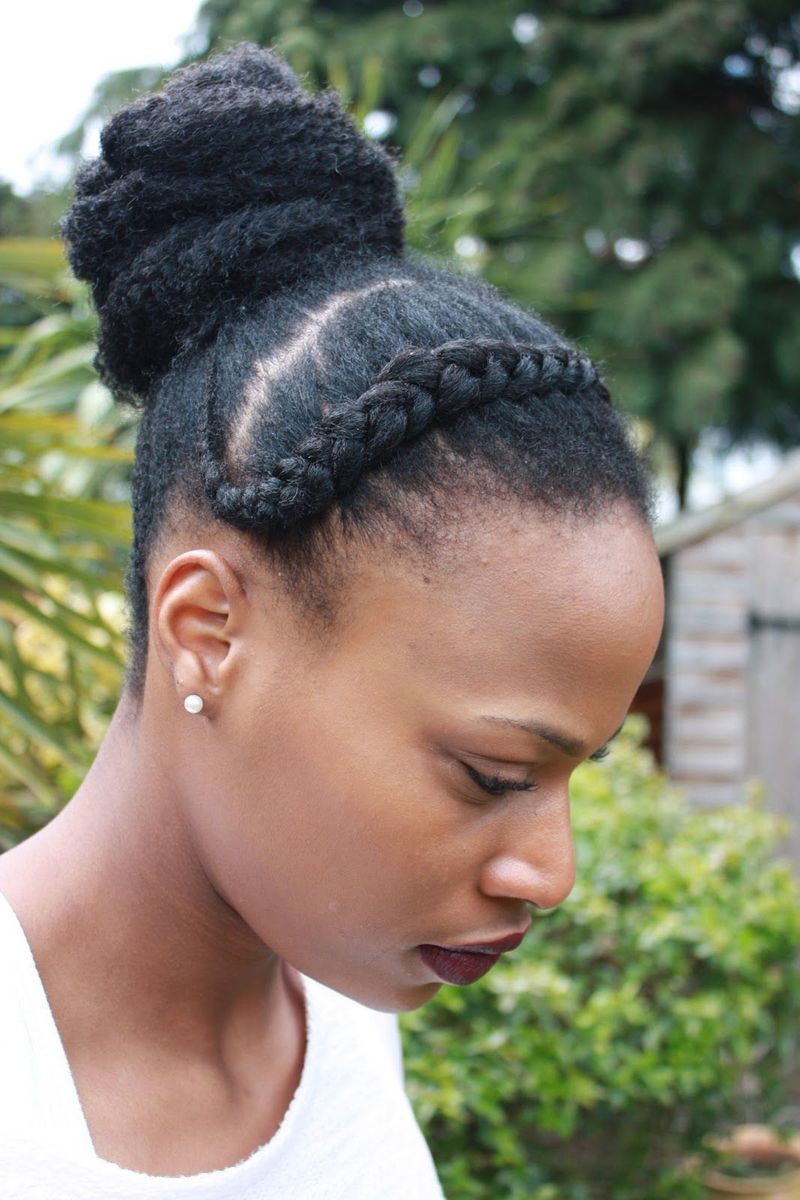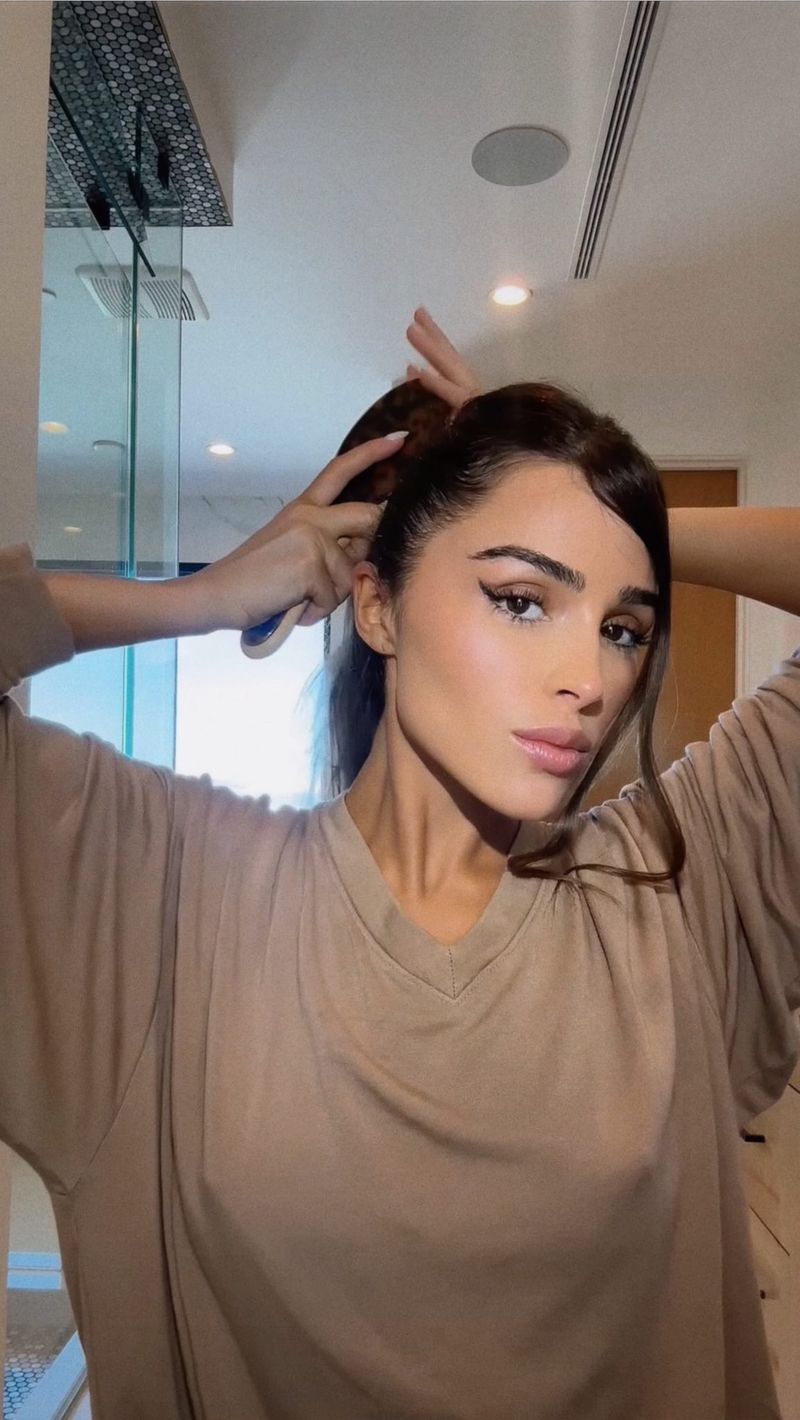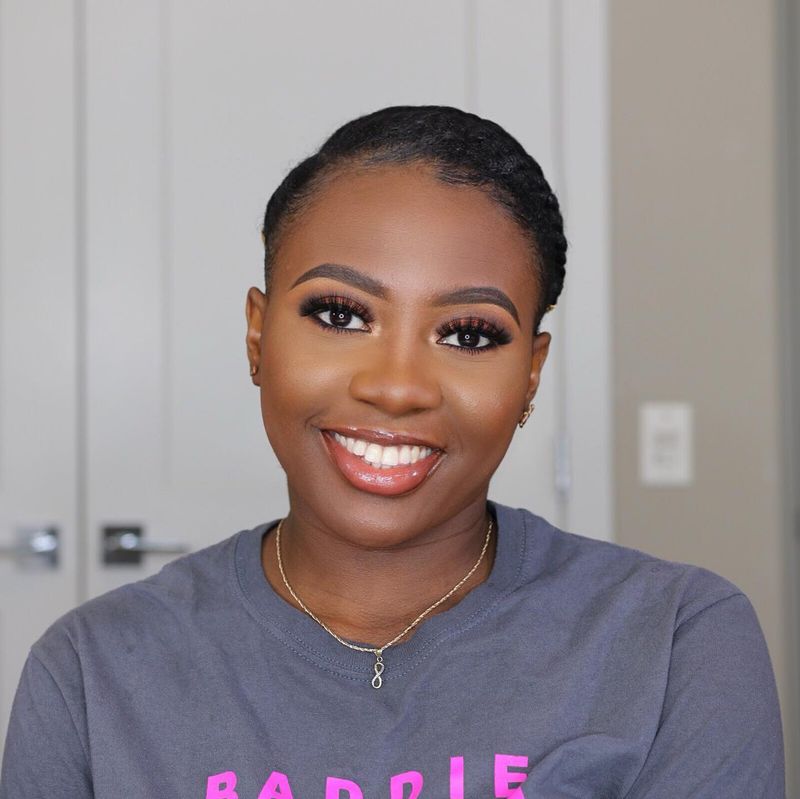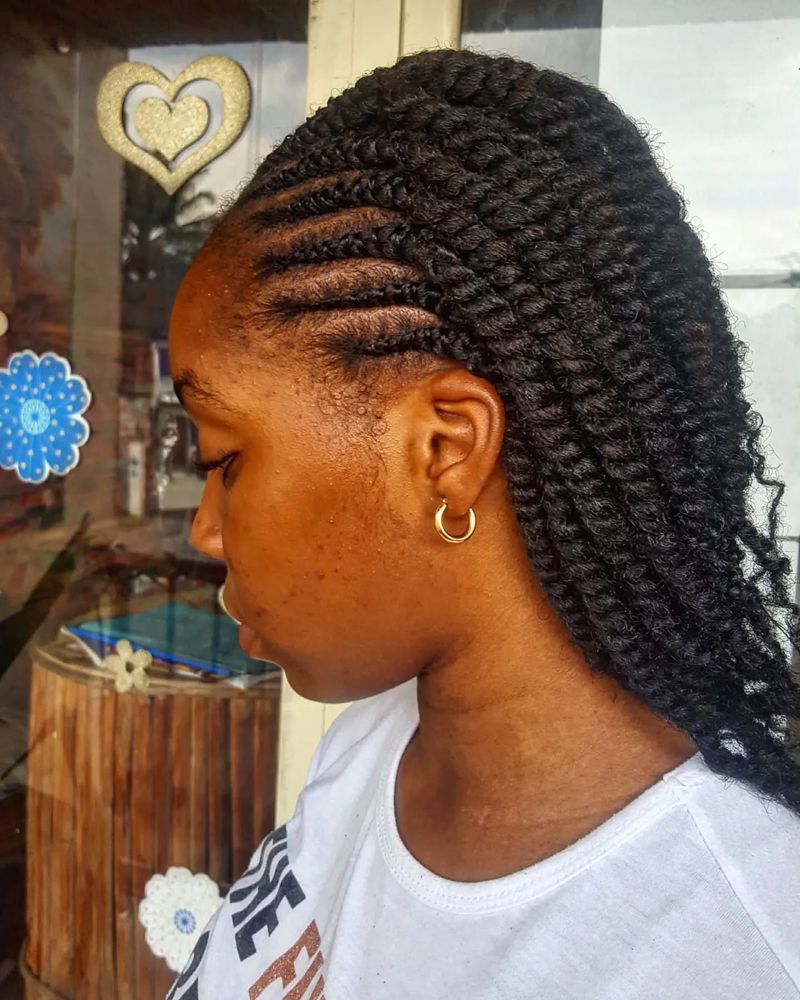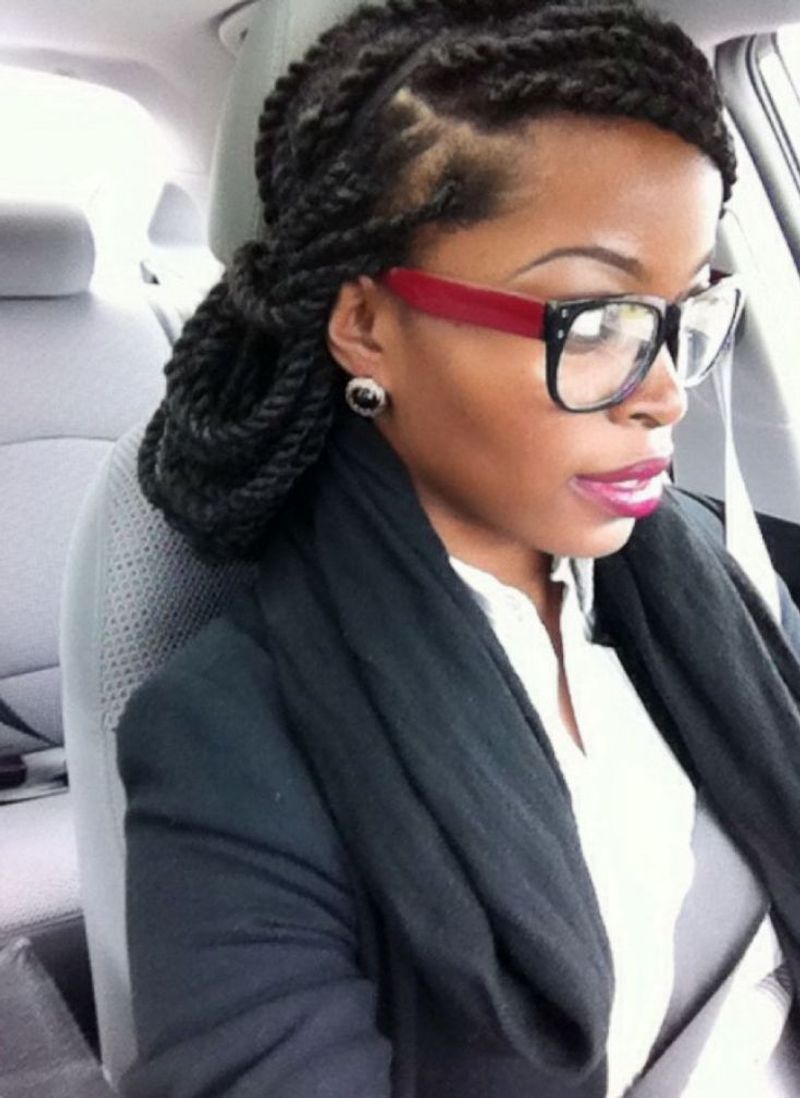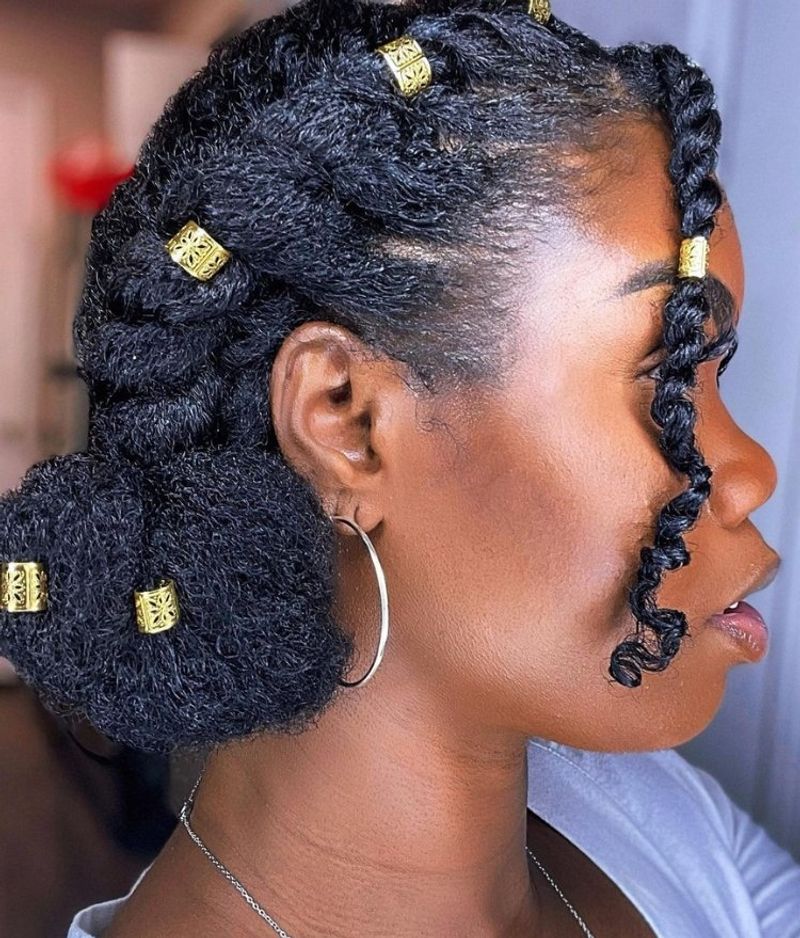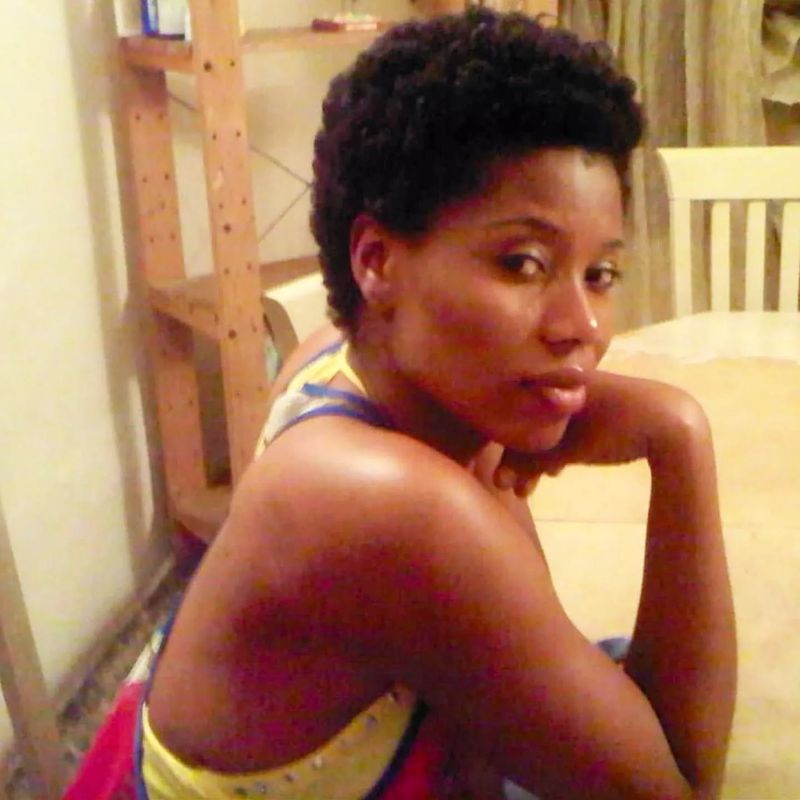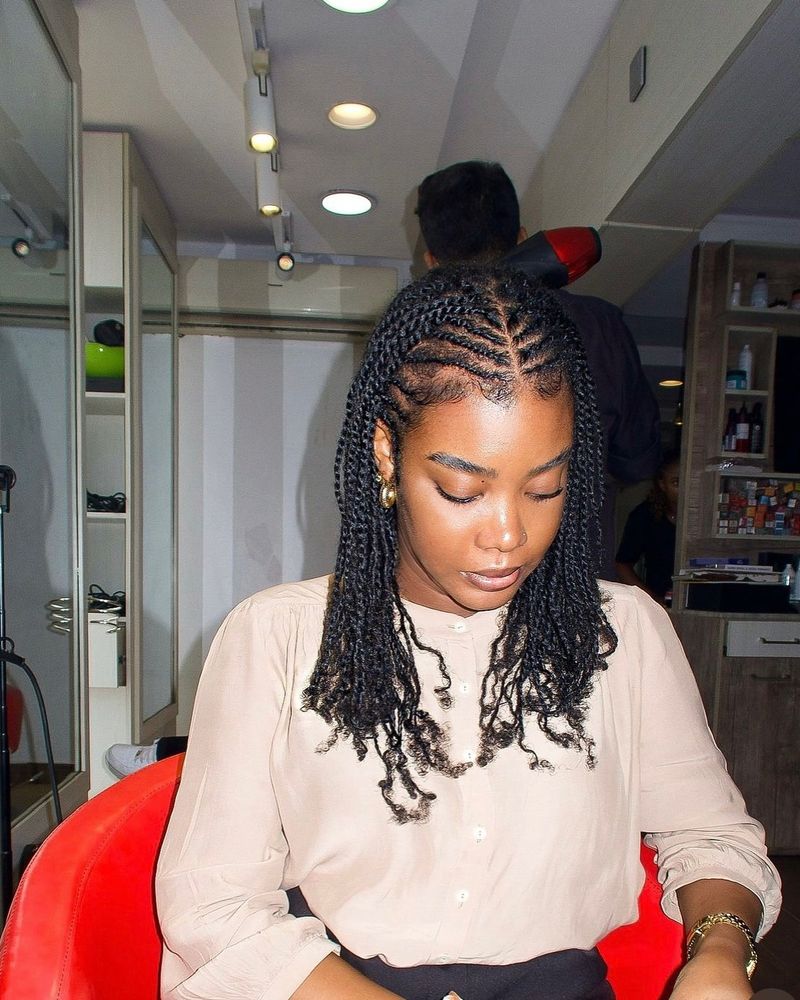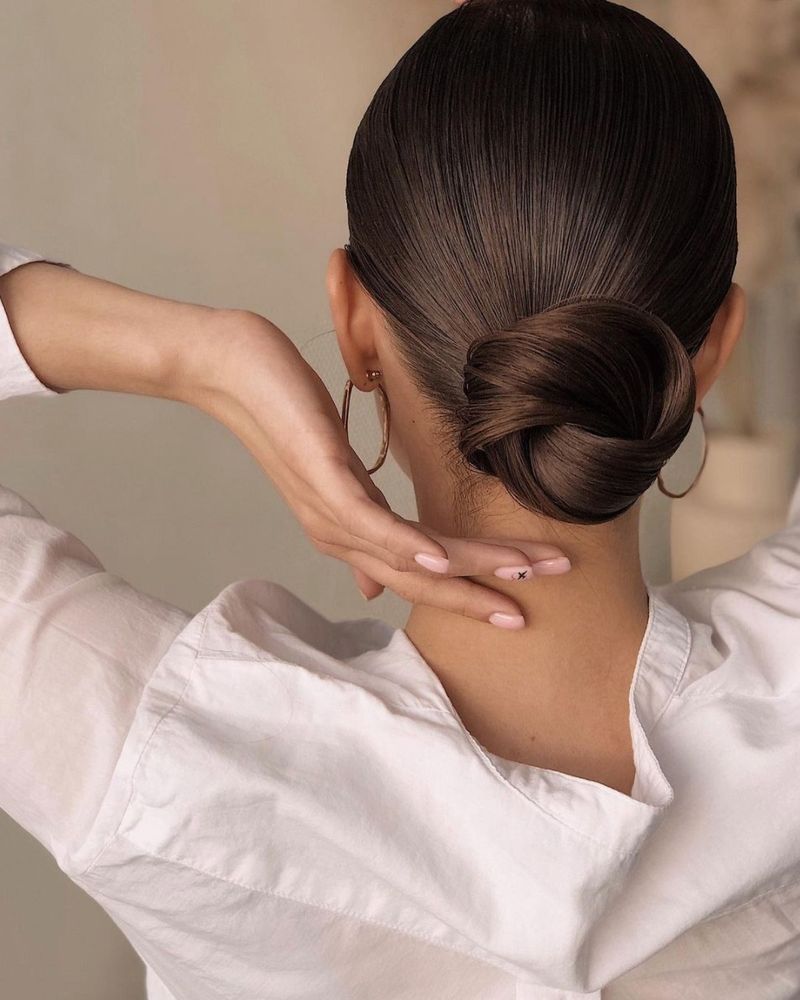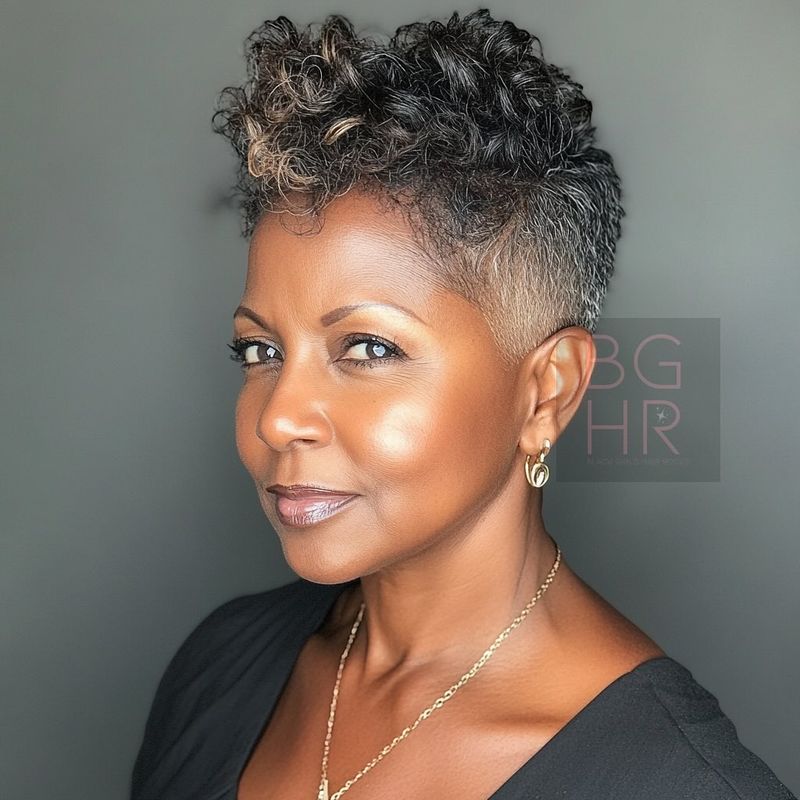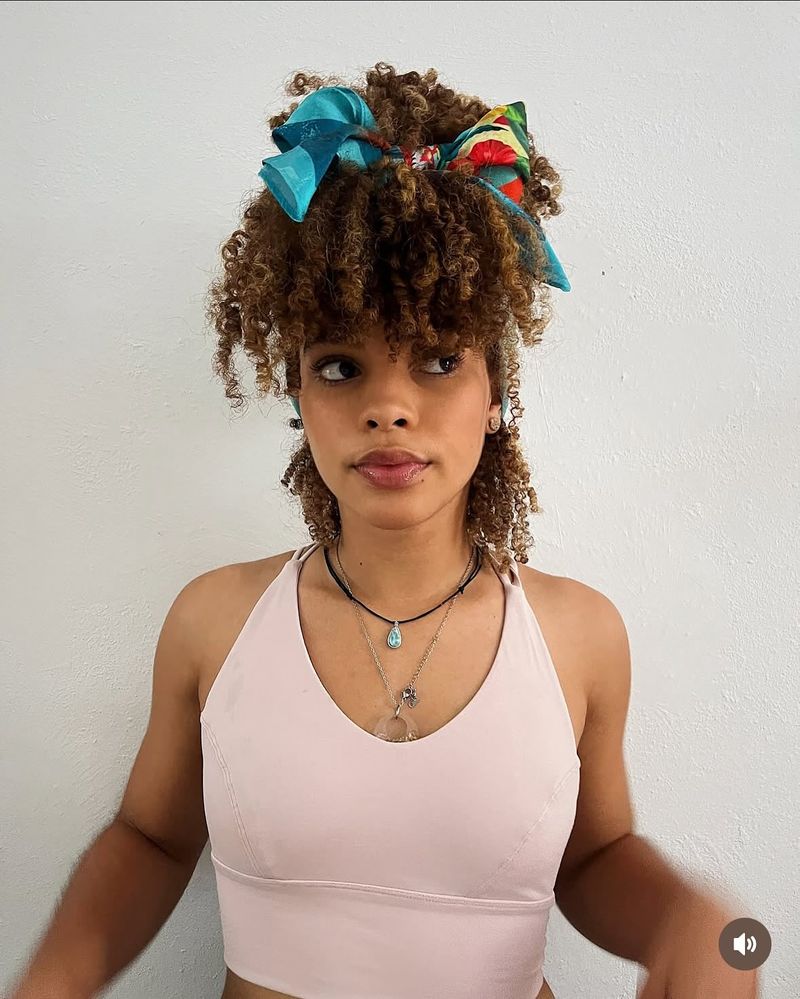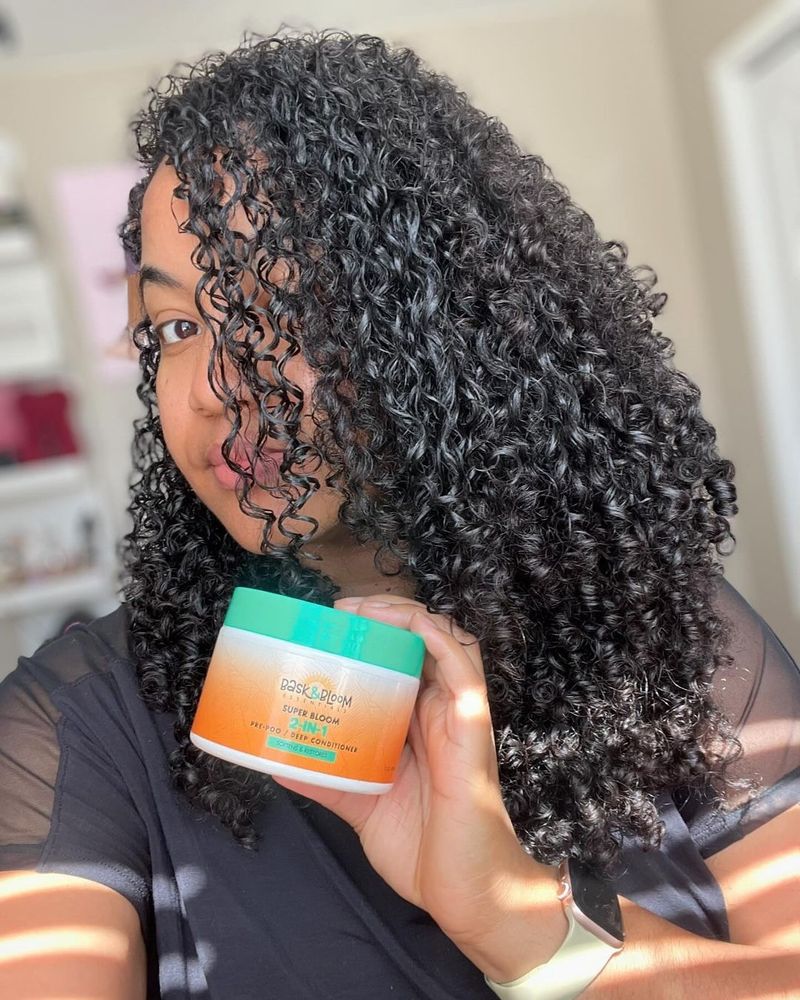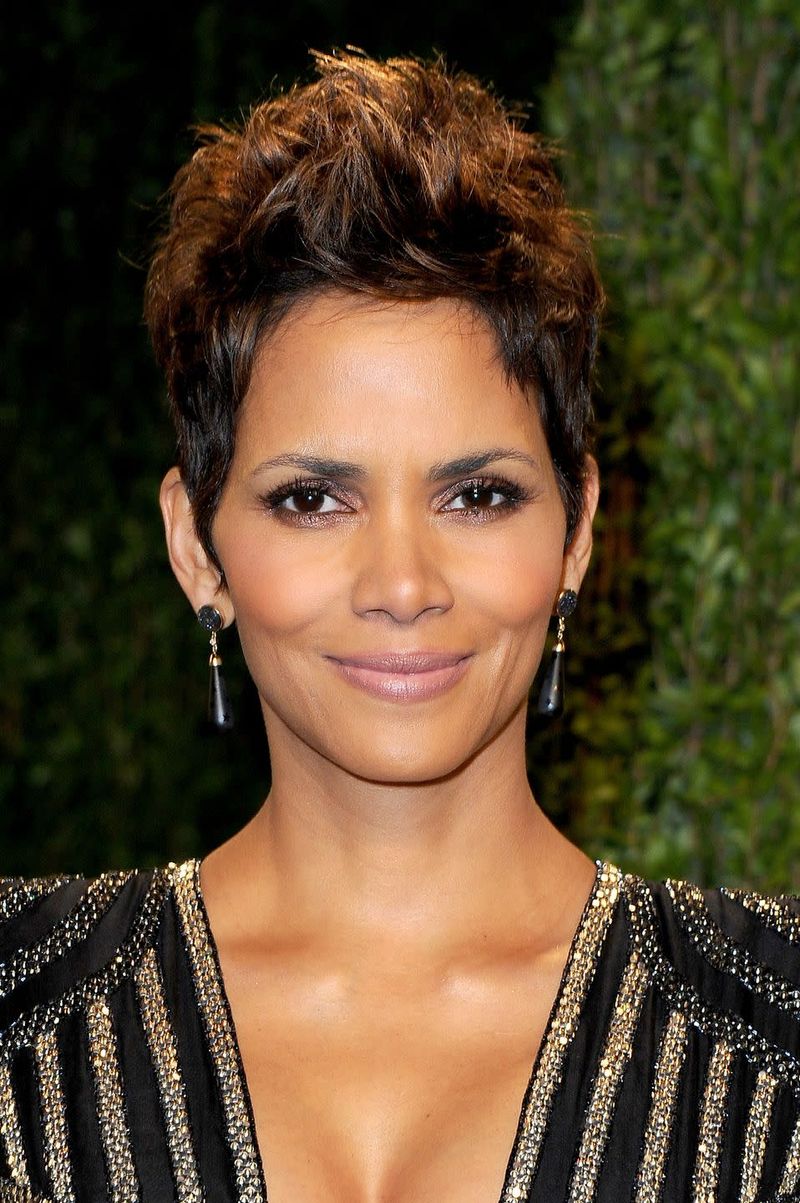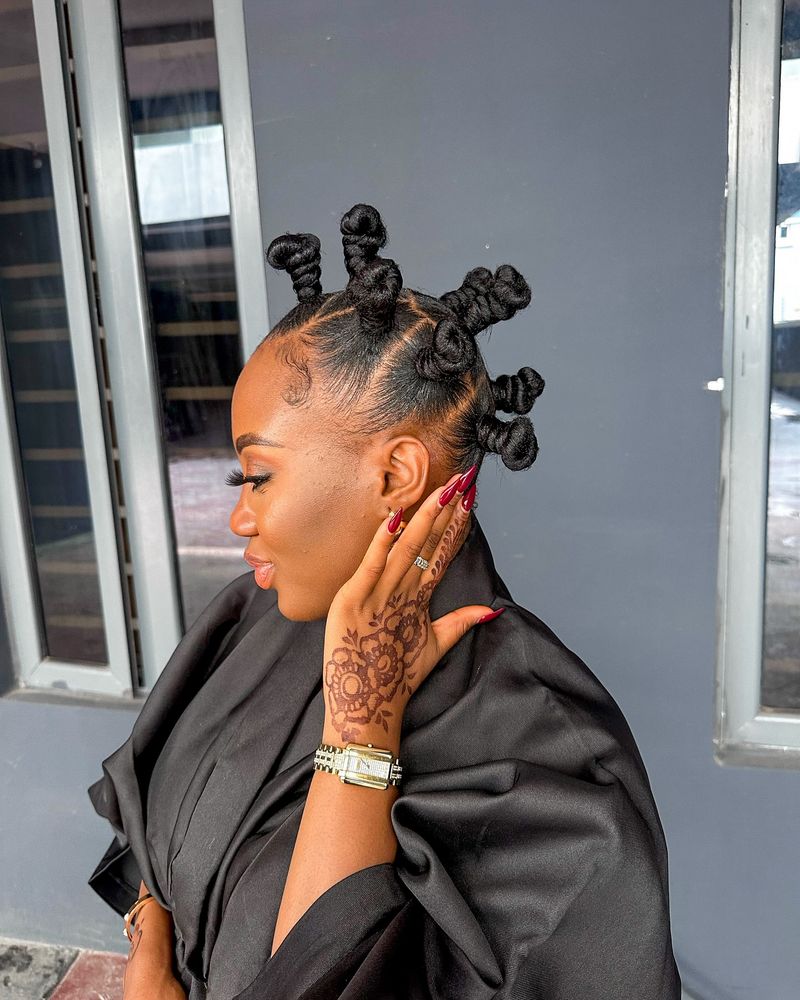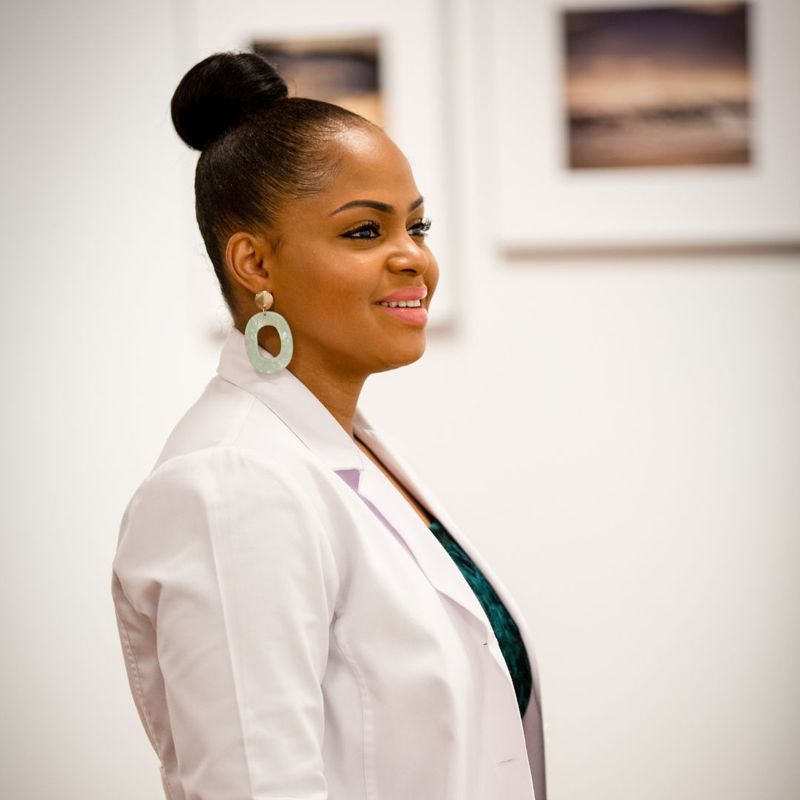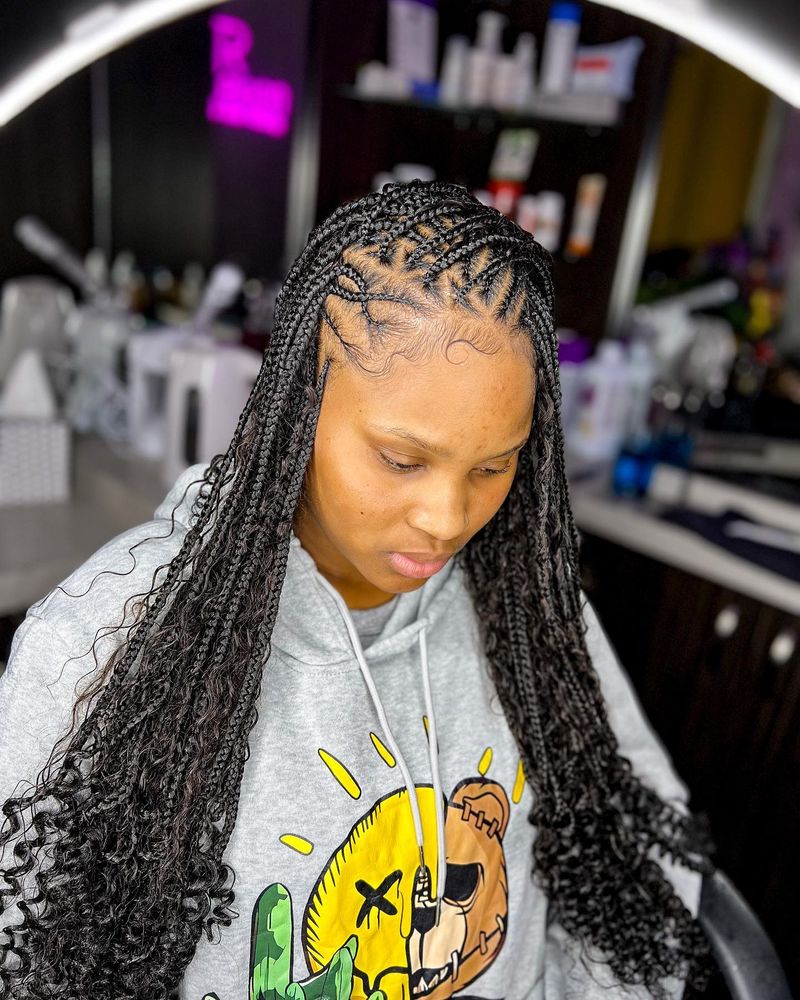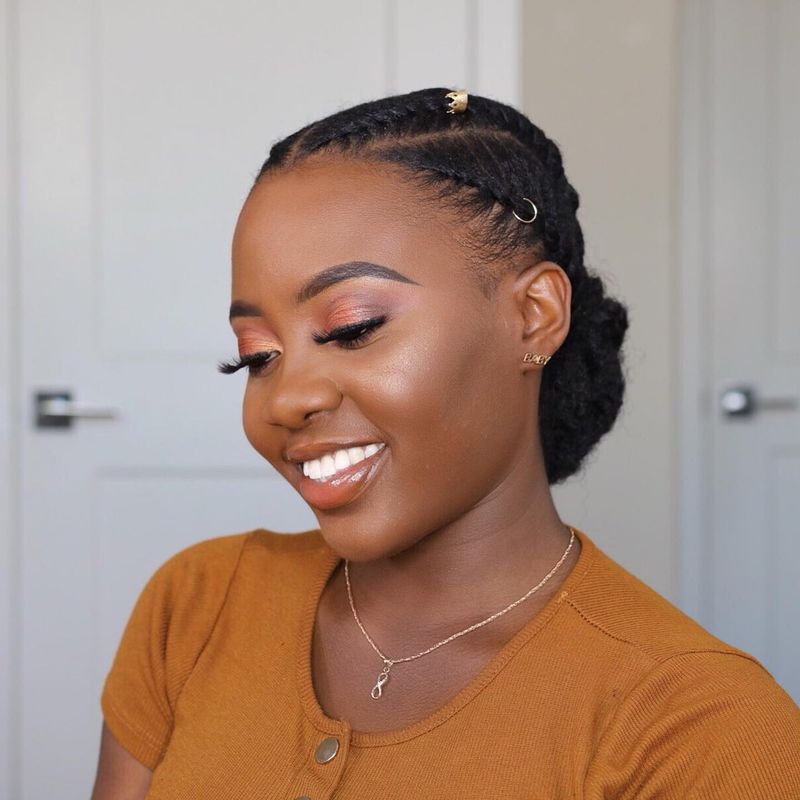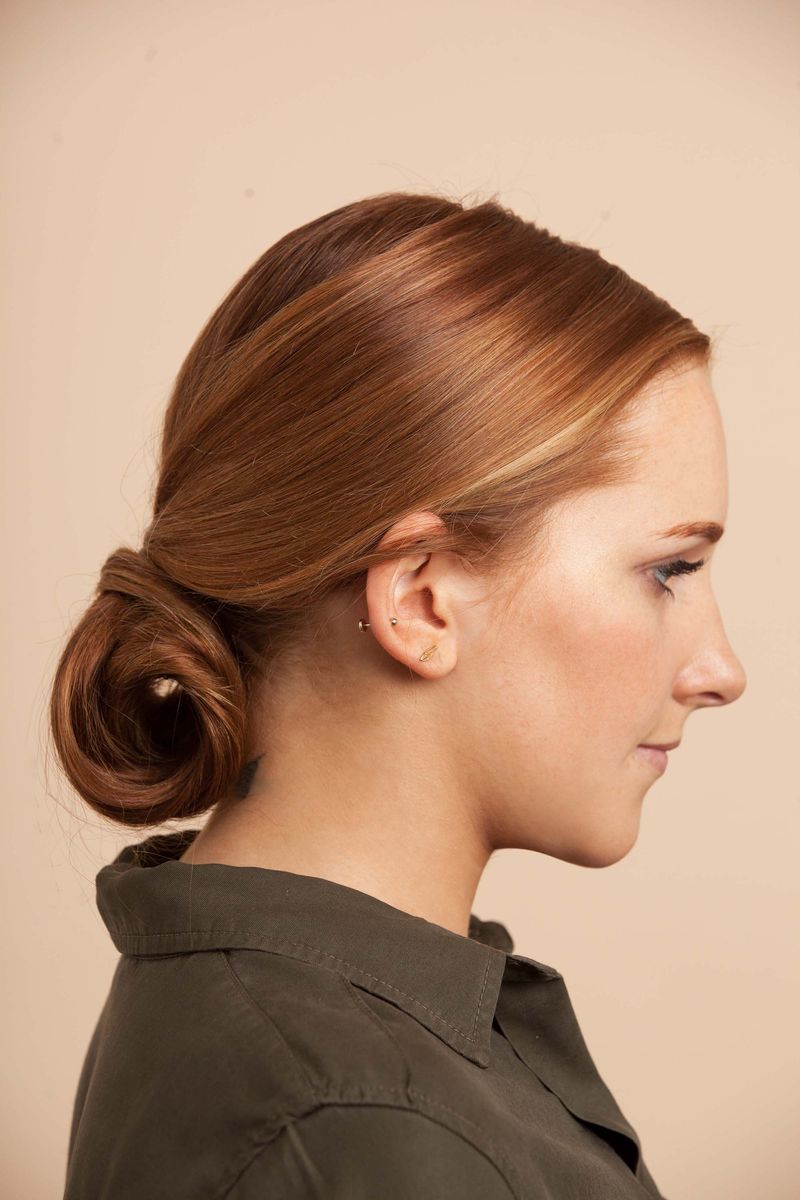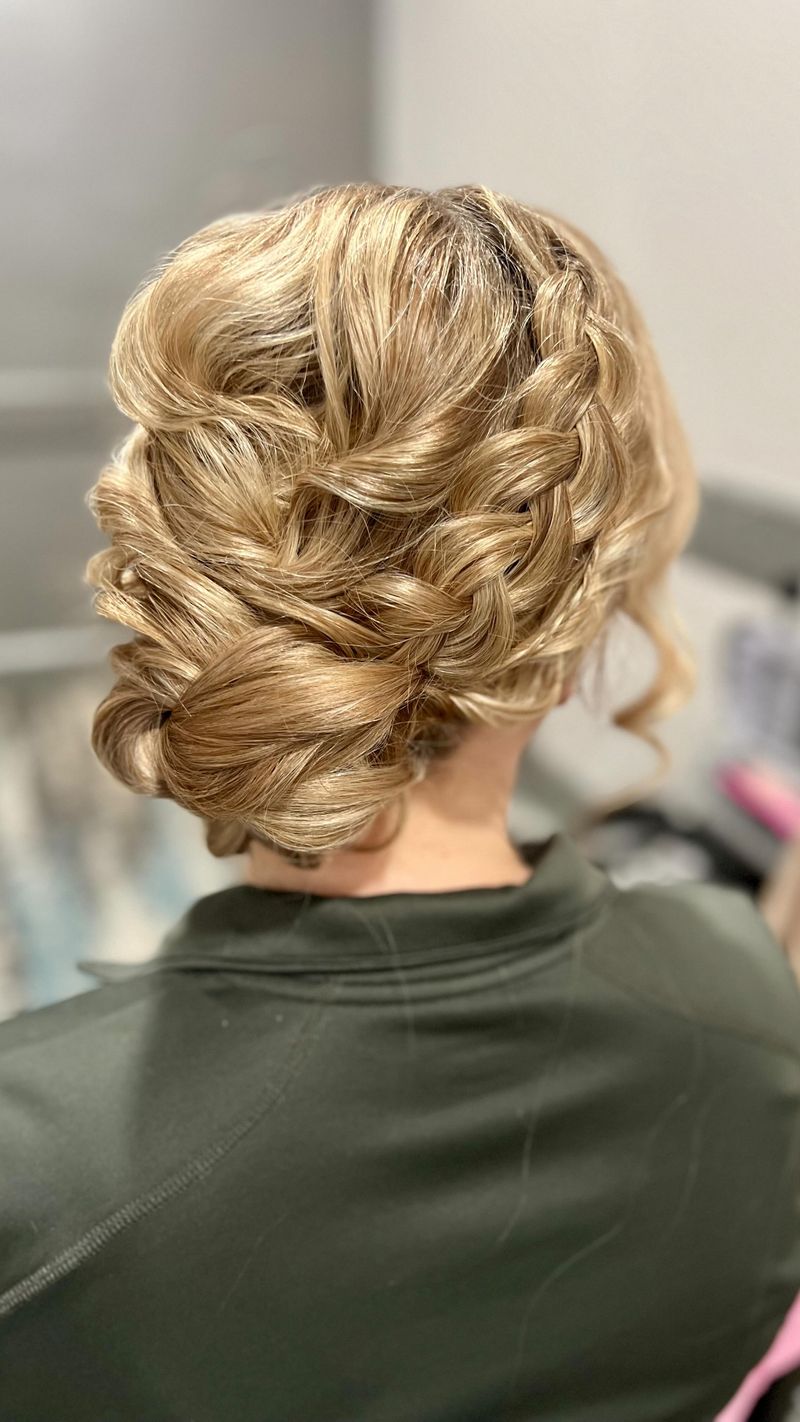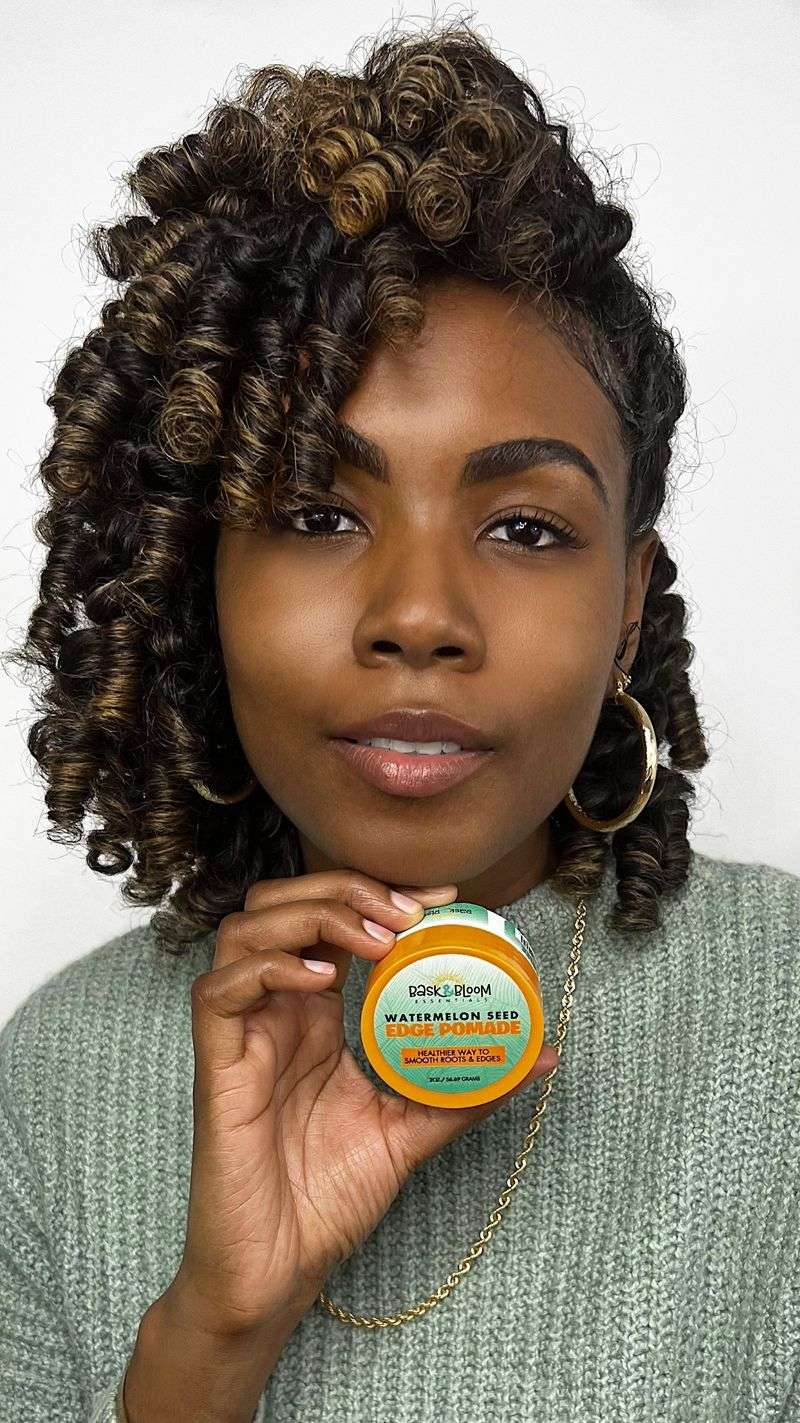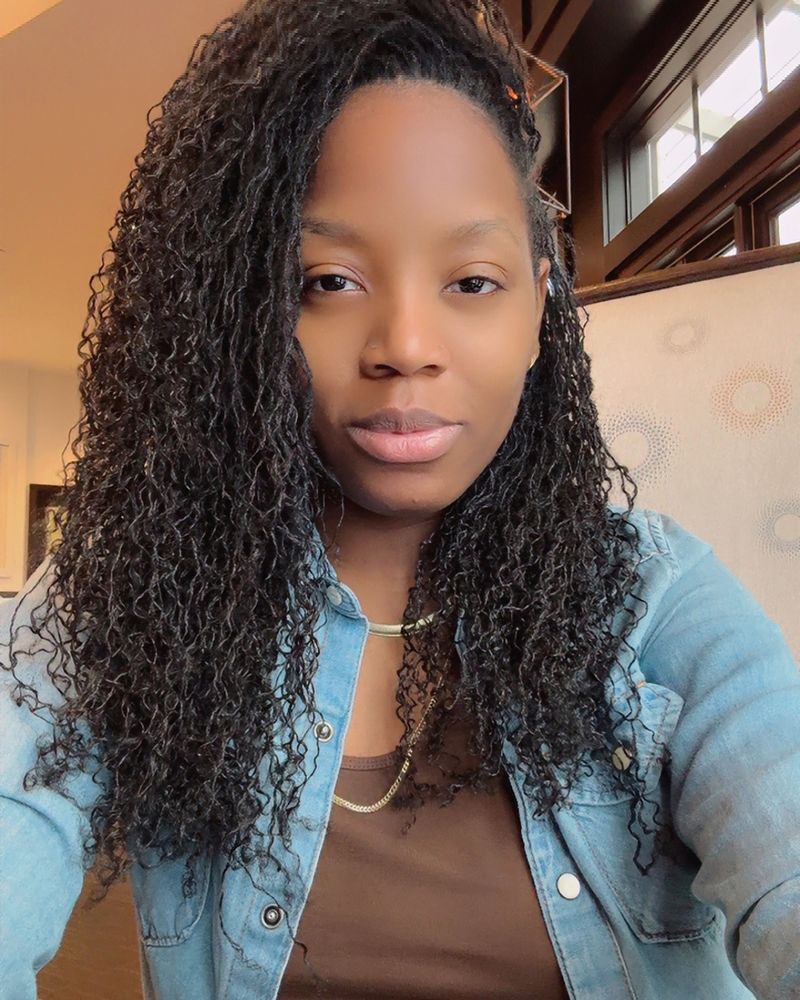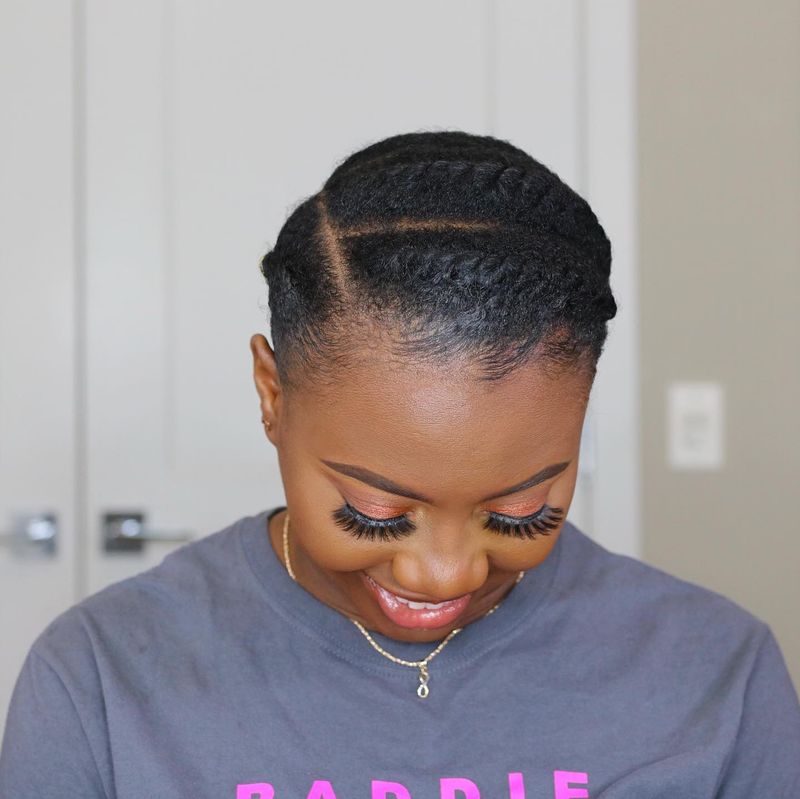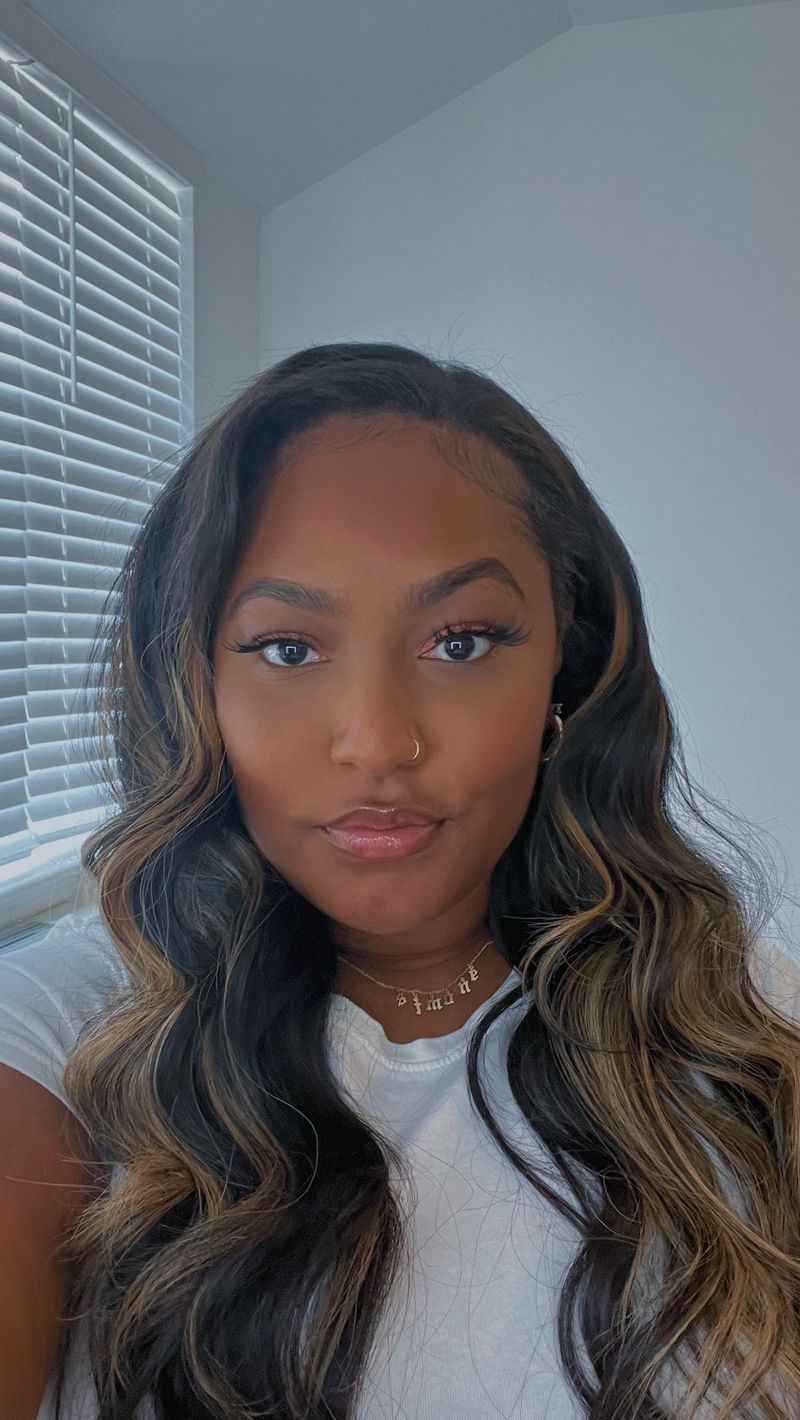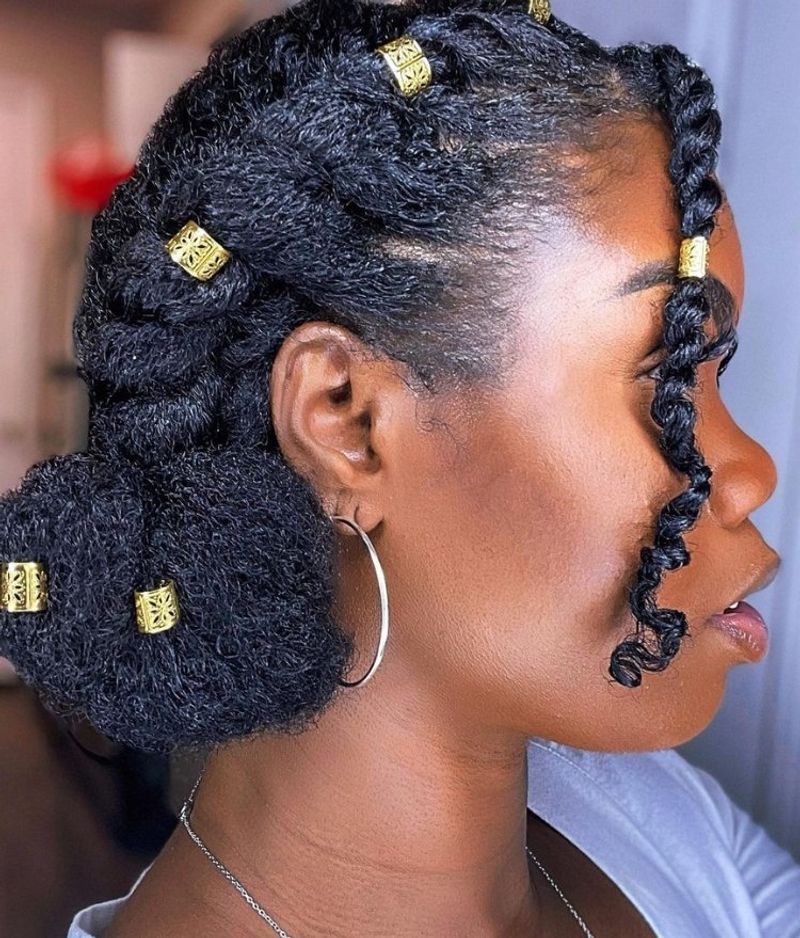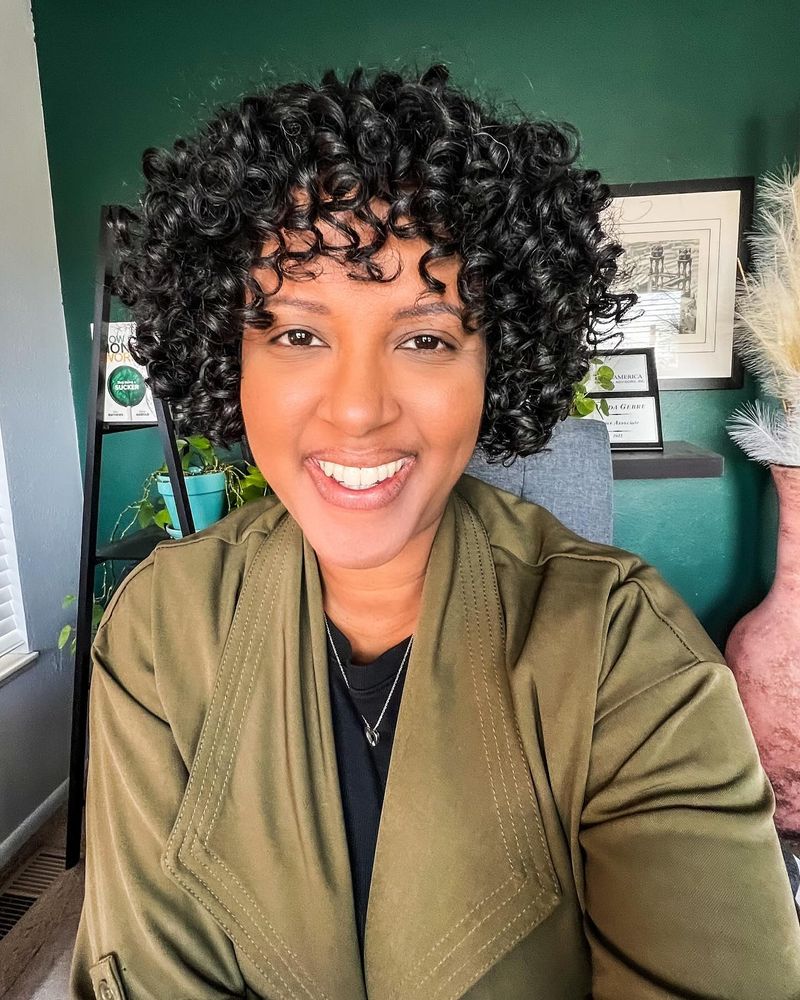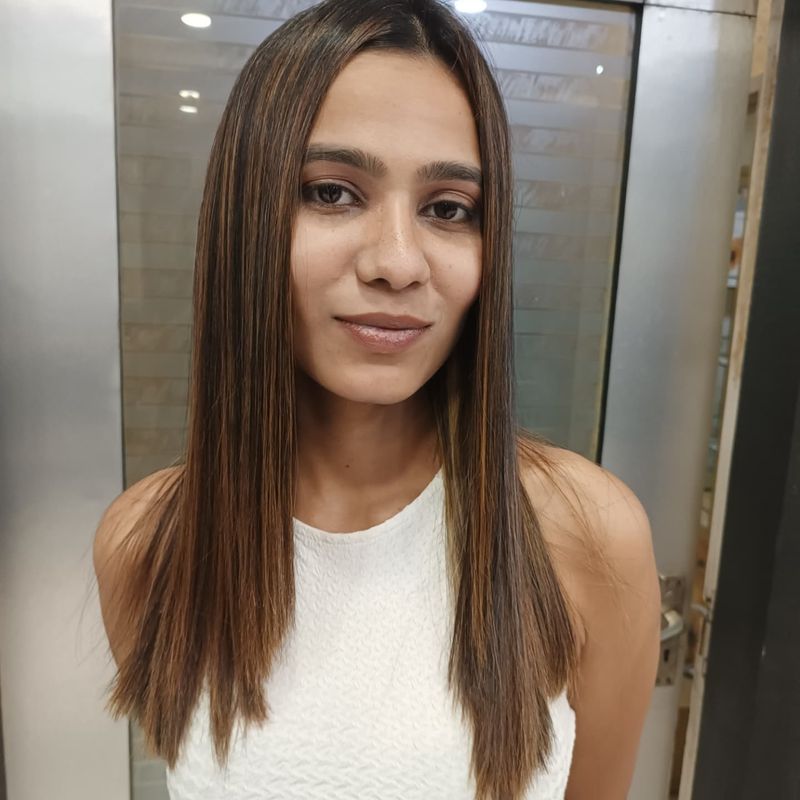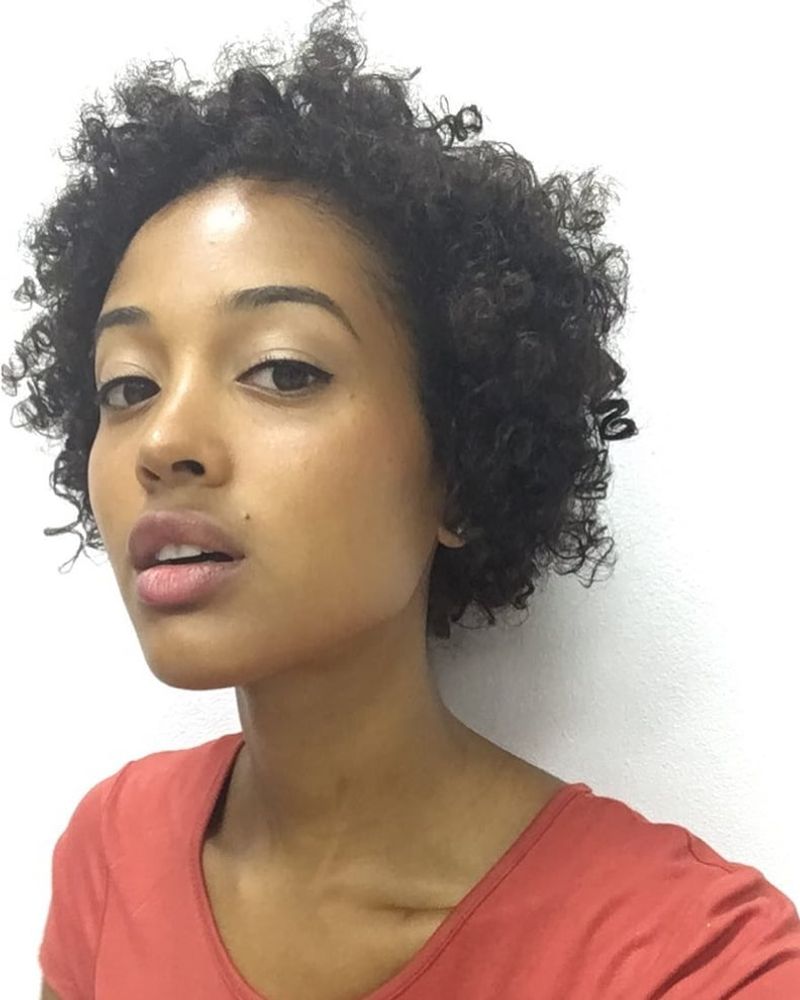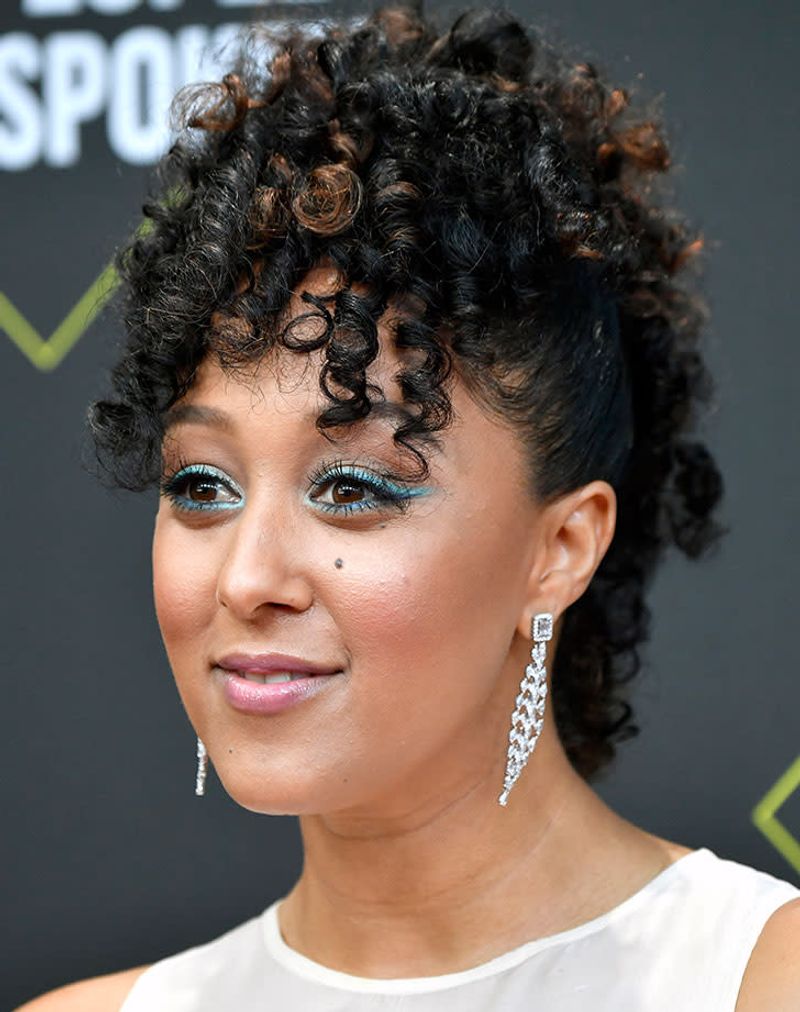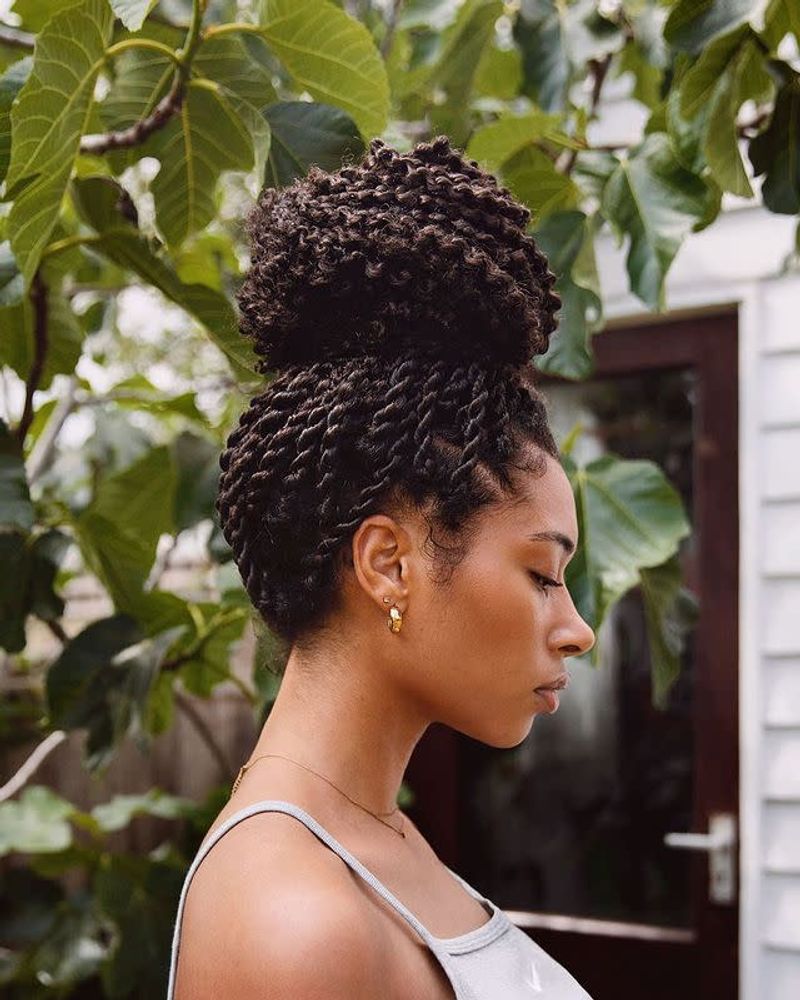32 Hairstyles For Job Interviews That Highlight Natural Hair
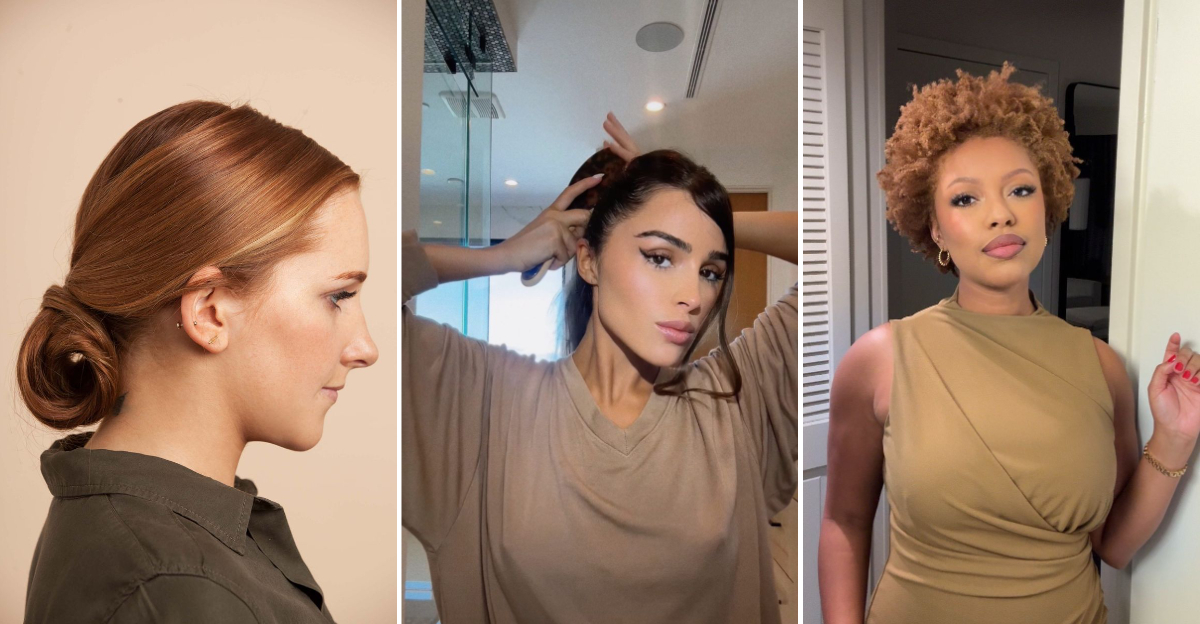
Job interviews can be nerve-wracking, especially when you’re wondering how to style your natural hair. I’ve been there too!
Finding professional styles that showcase your beautiful texture while maintaining that polished look is totally possible.
I’ve put together 32 interview-ready natural hairstyles that will help you walk into that meeting with confidence and let your skills—not outdated hair expectations—be the focus.
1. Low Puff with Side Part
A low puff with a side part creates instant polish without sacrificing your natural texture. I love how this style keeps hair away from your face while interviews get intense! The side part adds structure, making it office-appropriate while still celebrating your curls.
Just smooth your edges with a light gel, gather your hair at the nape of your neck, and secure with a covered elastic. For extra refinement, tuck in any loose ends and add a small accessory like a simple clip or pin that matches your outfit. This style works for all lengths beyond a TWA.
2. High Puff Crown
The high puff crown sits regally on top of your head, giving you that queen energy for your interview. I’ve worn this to countless meetings and always feel put-together yet true to myself. Gather your hair at the crown of your head using a satin scrunchie to prevent breakage.
The height elongates your face shape while keeping curls contained and professional. Make sure to smooth the front with a soft brush and minimal product for a clean finish. This style shines with medium to long hair lengths and works across all curl patterns.
3. Defined Twist-Out
A well-executed twist-out brings definition and controlled volume that screams polished professional. I remember landing my marketing job wearing this exact style! Set your twists the night before using a cream-based product for hold without crunch.
Unravel carefully in the morning, separating just enough for fullness without creating frizz. Shape the style with your fingers rather than combs or brushes to maintain definition. This versatile look works on all lengths and textures, giving you that perfect balance of personality and professionalism that interviewers remember.
4. Braid-Out with Volume
Braid-outs offer that perfect middle ground between texture and tidiness that hiring managers appreciate. The pattern creates a more structured curl that holds up throughout a long interview day. I always prep damp hair with a light hold mousse before braiding, then sleep on a satin pillowcase.
Unravel each braid carefully in the morning, fluffing just at the roots for volume while keeping the ends defined. The key is using the right number of braids—fewer for looser waves, more for tighter definition. This style photographs beautifully for those LinkedIn profile updates after you get the job!
5. Slicked-Back Bun
The slicked-back bun never fails to deliver that executive energy in conservative office environments. My friend Maria swears this style helped her land her banking position! Dampen your hairline and apply edge control with a small brush, smoothing everything toward the gathering point. Secure your bun with bobby pins that match your hair color, tucking ends neatly inside.
The beauty is in the simplicity—keep accessories minimal with perhaps just one decorative pin if appropriate. This timeless style works for virtually all hair lengths past your ears and adapts well to different textures.
6. Flat Twist Updo
Flat twist updos combine technical skill with artistic flair that shows attention to detail—something employers value. The structured nature keeps every strand in place through multiple interview rounds. Create 4-6 flat twists going toward the crown, then tuck and pin the ends into a neat circular pattern.
My secret weapon is a light spritz of shine spray to make it look fresh without appearing greasy. This style particularly flatters round and heart-shaped faces by creating visual length. It’s become my go-to for panel interviews where I need to look polished from all angles.
7. Two-Strand Flat Twists
Two-strand flat twists running back create clean lines that frame your face beautifully. The style keeps hair completely secure while highlighting your facial expressions—crucial during interviews where connection matters. I usually create 6-8 parallel twists going straight back, securing the ends with small clear elastics.
The pattern can be as simple or complex as your skill level allows, though keeping it symmetrical reads most professional. What makes this style interview-perfect is its staying power—no worrying about hair falling in your face when answering tough questions! Works wonderfully for short to medium length natural hair.
8. Halo Braid
The halo braid wraps around your head like a crown, giving off both strength and sophistication. I’ve gotten compliments from interviewers who appreciated the neat, thoughtful execution. Create one continuous braid that circles your head, securing with bobby pins that disappear into your hair texture. The key is maintaining even tension throughout for a smooth finish.
This protective style works beautifully for all face shapes and keeps every hair in place during those high-pressure moments. Bonus: it transitions perfectly from interview to first day on the job with zero maintenance needed.
9. Coiled Updo
A coiled updo gathers your natural texture into an architectural arrangement that speaks volumes about your attention to detail. The height and shape can be customized to flatter your specific face structure. Start with a twist-out or braid-out texture, then gather sections and pin them strategically to create dimension.
My technique involves using flat bobby pins in a cross-pattern for maximum hold without visible hardware. This style particularly shines for creative industry interviews where personal expression carries weight. The structured yet natural appearance bridges the gap between artistic and professional perfectly.
10. Teeny Weeny Afro (TWA)
The TWA exudes confidence and no-nonsense professionalism that many employers respond to positively. My cousin rocked this look during her law firm interviews and got offers from every single one! Keep your cut fresh with clean lines around the ears and nape. A light curl-defining cream brings out your natural pattern while taming any flyaways.
The beauty of the TWA for interviews is its low-maintenance perfection—no worrying about style collapse midway through. This look pairs especially well with statement earrings that show personality while maintaining that crisp, focused energy interviewers remember.
11. Crown Twist
The crown twist creates visual interest while maintaining absolute professionalism. I love how this style frames my face during interviews, keeping attention on my expressions and responses. Create a two-strand twist that wraps around the front hairline like a headband, pinning securely at the back.
The remaining hair can be styled in a puff, bun, or left in a twist-out depending on length. This style works across industries but especially shines in creative fields where thoughtful presentation matters. The dimensional look photographs beautifully for those post-interview LinkedIn updates when you land the position!
12. Low Bun with Middle Part
A low bun anchored with a clean middle part creates symmetry that reads as polished and intentional. The simplicity makes it appropriate for even the most conservative workplaces. Start with a precise middle part using the tail of a comb, then smooth sections back with a brush and light gel.
Gather at the nape, twist, and secure with pins that match your hair color. What makes this style interview-perfect is how it stays put through multiple handshakes and office tours. The balanced proportions work with all face shapes and photograph beautifully for those pre-interview LinkedIn updates.
13. Short Tapered Cut
A short tapered cut brings focus to your face while eliminating any hair-related stress during high-pressure interviews. The graduated length—shorter sides with slightly more length on top—creates a polished frame for your features. My friend Jasmine credits her tapered cut with helping her appear more confident and decisive in her executive interviews.
The style requires minimal morning prep—just a bit of moisturizer and perhaps a defining cream for the longer top section. The versatility makes this cut shine across industries, from creative to corporate. Bonus: it transitions seamlessly from interview to first day without any style adjustment needed.
14. Natural Curls with Headband
Free-flowing natural curls anchored with a thin, professional headband create that perfect balance of authentic and interview-appropriate. The headband adds structure while letting your beautiful texture shine. Choose a headband in a neutral color that either matches your hair or complements your outfit.
Position it about an inch back from your hairline to create a polished frame around your face. I’ve found this style particularly effective for interviews in education, social work, and creative fields where personality matters alongside qualifications. The approachable yet put-together look helps establish rapport with interviewers right from the handshake.
15. Soft Wash-and-Go
A carefully executed wash-and-go with well-defined curls strikes that perfect balance between natural and neat. The key for interviews is definition without excessive volume that might appear unkempt. My technique involves applying styling products to soaking wet hair in sections, then drying with a diffuser on low heat to maintain definition.
A light hold gel creates boundaries between curl clumps without crunchiness. Shape matters—trim regularly to maintain a deliberate silhouette rather than an undefined shape. This style particularly shines in progressive workplaces where authenticity is valued alongside professionalism.
16. Faux Hawk with Flat Sides
The natural hair faux hawk with neatly flattened sides brings edge and personality while maintaining interview-appropriate boundaries. The structured style shows creativity within professional parameters. Create this by smoothing the sides with a brush and gel, then using bobby pins to secure them flat while leaving the center section higher and textured.
The contrast between sleek sides and textured top creates visual interest without being distracting. This style works particularly well for interviews in design, technology, and media where creative thinking is valued. The deliberate execution demonstrates attention to detail—something all employers appreciate.
17. Bantu Knots Tucked into Bun
Bantu knots strategically positioned and tucked into a low bun create a unique textural element while maintaining a conservative silhouette. This style showcases cultural pride within professional parameters. Create 6-8 medium-sized Bantu knots in the front section, then gather the remaining hair into a low bun at the nape.
The dimensional look catches light beautifully while keeping everything secure during those high-pressure moments. I especially recommend this for interviews in education, arts, and community organizations where cultural awareness is valued. The intentional execution shows creativity and precision—qualities that translate well to job performance.
18. Roll and Tuck Style
The roll and tuck technique creates elegant contours that frame your face beautifully during interviews. Think modern Gibson girl with natural texture! Section hair horizontally, then roll each section inward and secure with flat bobby pins. The technique works with various textures and lengths beyond shoulder-length, creating a timeless silhouette that never reads as trendy or inappropriate.
My colleague landed her hospital administration role wearing this exact style—it conveyed competence and attention to detail without drawing attention away from her qualifications. The tucked ends ensure nothing falls out of place during those marathon interview sessions.
19. Chunky Twist Crown
Chunky twists arranged in a crown formation create dimension and interest while maintaining a professional silhouette. The style keeps hair completely secure while showcasing your natural texture. Create 8-10 medium-sized two-strand twists, then wrap them around your head, pinning securely where they meet.
The thickness of each twist shows off your texture while the circular arrangement creates a polished frame for your face. This style particularly impresses in interviews for positions requiring both creativity and organization—the structured yet textured look perfectly embodies both qualities. Plus, it transitions beautifully from interview to celebration dinner when you get the offer!
20. Puff with Flat Twist Front
A puff anchored with flat twists along the front hairline creates structure that frames your face beautifully. The combination offers the best of both worlds—neat edges with textural interest. Create 2-4 flat twists along your hairline going toward the crown, then gather the remaining hair into a puff at your desired height.
The contrast between the sleek twists and the textured puff creates visual interest while maintaining professionalism. This style particularly shines for interviews in education and social services where approachability matters. The neat execution shows attention to detail while the natural texture conveys authenticity—a winning combination!
21. Braided Low Bun
A braided low bun combines texture and tidiness in one interview-perfect package. The braided elements add interest while the low bun placement keeps everything secure and professional. Create several braids of your preferred size, then gather them all at the nape of your neck and wrap into a bun formation. Secure with pins that match your hair color for an invisible hold.
My sister wore this style to her nursing job interview and received compliments on how neat yet distinctive it looked. The style works across industries but especially shines in healthcare and education where put-together appearance matters.
22. Chignon with Natural Texture
A textured chignon positioned at the nape creates timeless elegance that works in even the most conservative interview environments. The style elevates your natural texture into something classically professional. Gather hair at the nape, twist loosely, then tuck and pin the ends underneath to create that signature chignon shape.
The beauty is in the imperfection—allow some texture to show while maintaining the clean silhouette. My banking friend swears this style helped her appear both trustworthy and current during her financial sector interviews. The low placement ensures it looks appropriate from all angles during those multi-interviewer sessions.
23. Curly High Bun
A high bun that showcases your curly texture creates height and elegance that photographs beautifully for those LinkedIn headshots. The elevated placement draws attention to your face—perfect for making memorable first impressions. Gather hair at the crown, loosely twist, and secure with pins, allowing some curly ends to create dimension at the top.
The controlled volume reads as intentional rather than messy when executed with precision. This style particularly shines for interviews in marketing, public relations, and client-facing roles where polished presentation matters. The balance of professional structure with natural texture shows both personality and attention to detail.
24. Twisted Side Bun
A twisted side bun creates asymmetrical interest that frames your face from the perfect angle during interviews. The lateral placement adds a modern touch to this otherwise classic style. Create a deep side part, then twist sections of hair toward the lower side, securing into a bun behind your ear.
The intentional asymmetry works beautifully for both in-person and video interviews by creating a defined silhouette. My colleague in publishing received compliments on this style during her editorial job interviews—it conveyed creativity within professional boundaries. The side placement keeps hair completely away from your face during those high-stakes conversations.
25. Updo with Braided Sides
An updo anchored with braided sides creates structure and security that lasts through multiple interview rounds. The braided elements add intentional detail while keeping everything perfectly in place. Create tight braids along both sides going toward the back, then gather the remaining hair into an updo of your choice—a bun, twist, or tuck all work beautifully.
The contrast between the sleek braids and the textured updo creates dimension without appearing casual. This style particularly impresses in interviews for positions requiring both creativity and precision, like architectural design or project management. The thoughtful execution demonstrates attention to detail that translates well to job performance.
26. Flexi Rod Set Pulled Back
A flexi rod set with the front sections pulled back creates defined curls with interview-appropriate structure. The pulled-back front keeps your face fully visible while showcasing those beautiful spiral curls. Set your hair on medium-sized flexi rods the night before, then release in the morning for bouncy, defined curls.
Gently pull the front sections back and secure with decorative pins or a small clip that complements your outfit. My marketing friend calls this her “secret weapon” style for creative industry interviews. The defined curls demonstrate attention to detail while the pulled-back front ensures nothing distracts from your face during important conversations.
27. Twist-and-Pin Updo
The twist-and-pin technique creates a customized updo that works with your unique texture and length. The seemingly effortless style actually demonstrates careful execution—a quality employers value. Take small sections of hair, twist them loosely, then pin strategically to create your desired shape.
The beauty lies in the organic arrangement—no two twist-and-pin styles look exactly alike, much like your unique qualifications. My colleague in human resources notes that this style conveys both creativity and reliability in interviews. The secure pinning ensures nothing falls out of place during those marathon interview days, while the textured finish shows personality within professional boundaries.
28. Curly Bob with Side Part
A well-shaped curly bob with a defined side part frames your face perfectly during interviews. The contained length reads as intentional rather than simply grown out. The key is in the cut—make sure your stylist shapes it to curl up slightly at the ends rather than hanging limply. A deep side part creates structure that looks deliberate and polished during face-to-face conversations.
My friend in legal services found this style perfect for her conservative office interviews—it honored her natural texture while maintaining appropriate volume and shape. The bob length means no fussing with your hair during those high-pressure moments.
29. Side-Swept Natural Fro
A side-swept natural fro creates asymmetrical interest while maintaining a deliberate shape. The directional styling reads as intentional rather than simply uncontained. Shape your fro with a pick at the roots, then use a combination of your fingers and a wide-tooth comb to direct more volume to one side.
A light hold spray helps maintain the shape without compromising your natural texture. This style particularly shines in interviews for creative industries like design, media, and marketing. The controlled yet expressive shape shows personality while still appearing thoughtfully executed—exactly the balance many progressive employers seek.
30. Sponge Curls with Clean Edges
Sponge-defined curls paired with clean, sharp edges create the perfect balance of texture and precision. The contrasting elements show attention to detail that employers notice. Use a curl sponge on slightly damp hair to create uniform coils throughout, then define your edges with a small amount of edge control and a soft brush.
The crisp hairline frames your face beautifully during those important first impressions. My brother in financial technology swears this style helped him appear both current and professional in his interviews. The neat execution works particularly well for shorter natural styles where texture and shape are everything.
31. Finger Coils with Side Sweep
Finger coils styled with a side sweep create definition with directional interest. The technique showcases your natural texture in its most refined form. Create uniform coils using a curl-defining product and your fingers, working in small sections.
Once dry, gently direct the coils to favor one side, creating that polished side-swept effect that frames your face during conversations. My friend in healthcare administration found this style perfect for her director-level interviews—it demonstrated precision and attention to detail while honoring her natural texture. The defined coils maintain their shape throughout long interview days.
32. Mini Twists in Half-Updo
Mini twists gathered into a half-updo create texture with structure that works beautifully across industries. The style keeps hair away from your face while showcasing your natural pattern. Install small two-strand twists throughout your hair, then gather the top half and secure with a decorative clip or pins that complement your interview outfit.
The contrast between the secured top and the hanging bottom creates dimensional interest. My teaching colleague credits this style with helping her appear both approachable and professional in her education interviews. The neat execution demonstrates patience and attention to detail—qualities that translate well to job performance.
